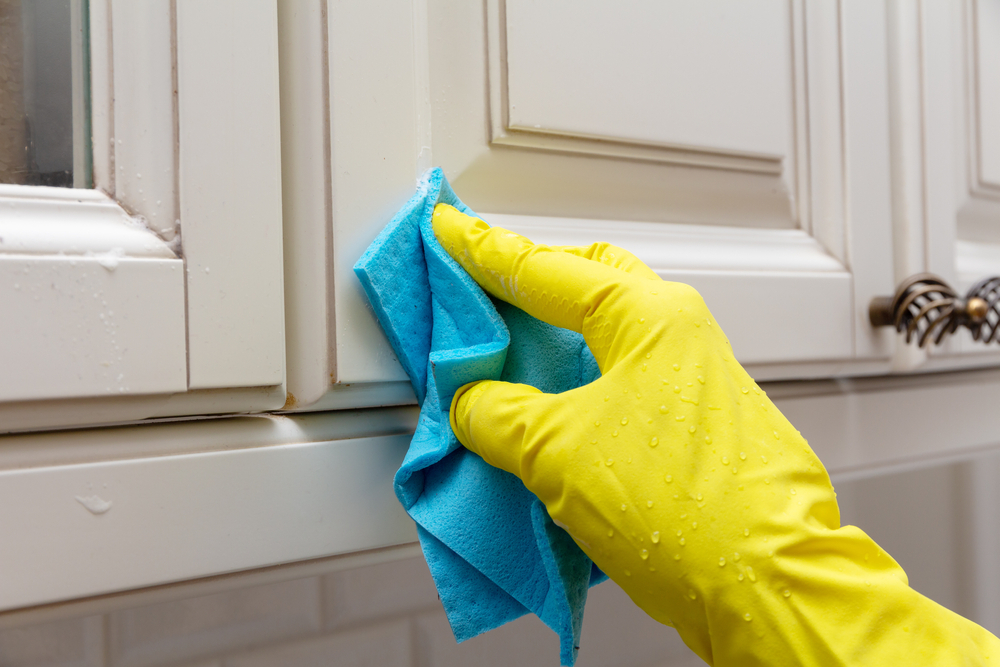Cleaning kitchen grease from cabinets is an essential task to maintain a clean and hygienic cooking space. Over time, the buildup of grease can make cabinets look dull and sticky, and it can be a challenge to remove. How to clean kitchen grease from cabinets? With the right techniques and cleaning products, you can effectively eliminate grease stains and restore shine to your kitchen cabinets.
Whether you’re dealing with light residue or stubborn grease spots, this guide will provide you with valuable tips and step-by-step instructions to tackle the grease and bring back the luster to your cabinets.
How to Know Kitchen Grease Buildup?
To determine if your kitchen cabinets have grease buildup, there are several signs you can look out for:
- Visual Inspection: Take a close look at your cabinets. Grease buildup often appears as a yellowish or brownish film on the surfaces. It may be more noticeable around the handles or near the stove area.
- Touch and Texture: If your cabinets feel sticky or tacky to the touch, it’s likely due to grease accumulation. The residue can attract dust and make the cabinets harder to clean.
- Lingering Odor: Grease buildup can emit a distinct, lingering smell in the kitchen. If you notice an unpleasant or greasy odor, it’s a sign that your cabinets may need cleaning.
- Difficulty in Opening/Closing: Excessive grease can make cabinet doors and drawers harder to open and close smoothly. If you experience resistance or a sticky sensation when operating them, it could indicate grease buildup.
Tools & Materials
- Dish soap
- Warm water
- Sponge or microfiber cloth
- Spray bottle
- White vinegar
- Baking soda
- A clean, damp cloth
Method 1: Dish soap and warm water
- Start by mixing a few drops of dish soap with warm water in a bowl or bucket.
- Dip a clean sponge or microfiber cloth into the soapy solution and gently scrub the greasy areas of your cabinets.
- Pay extra attention to the areas near handles and knobs, as they tend to accumulate more grease.
- Rinse the sponge or cloth frequently in soapy water, and continue until you have covered all the greasy spots.
- Finish by wiping the cabinets with a clean, damp cloth to remove any remaining soap residue.
Method 2: Vinegar solution
- Vinegar is a versatile household ingredient known for its grease-cutting properties.
- Create a cleaning solution by mixing equal parts of white vinegar and warm water in a spray bottle.
- Spray the solution directly onto the greasy cabinet surfaces and let it sit for a few minutes to loosen the grease.
- Then, using a sponge or cloth, scrub the cabinets in a circular motion. For stubborn grease stains, you can add a small amount of baking soda to the vinegar solution to create a paste.
- After cleaning, wipe down the cabinets with a damp cloth to remove any vinegar residue.
Method 3: Baking soda paste
- Baking soda is another excellent natural cleaner that can help eliminate kitchen grease.
- To make a baking soda paste, mix baking soda with a small amount of water until you achieve a thick consistency.
- Apply the paste to the greasy areas of your cabinets and let it sit for a few minutes. Then, using a sponge or cloth, scrub the cabinets gently in a circular motion.
- Baking soda’s abrasive properties will help lift the grease stains.
- Once you have cleaned the cabinets, wipe them down with a clean, damp cloth to remove any residue.
Dry and Polishing
After you have successfully removed the grease from your kitchen cabinets, it is important to properly dry and polish them to restore their shine and protect the surfaces. Here are the steps to follow:
- Remove Excess Moisture: Use a clean, dry cloth or paper towel to remove any remaining moisture from the cabinet surfaces. Make sure to reach into corners and crevices where water may have accumulated.
- Air Dry: Allow the cabinets to air dry for a short period of time to ensure all moisture evaporates. Open windows or turn on fans to promote air circulation and expedite the drying process.
- Apply Cabinet Polish: Once the cabinets are completely dry, choose a suitable cabinet polish or furniture wax. Apply a small amount of the polish onto a soft, lint-free cloth.
- Polish the Surfaces: Gently rub the polish onto the cabinet surfaces, following the grain of the wood, if applicable. Use circular motions to evenly distribute the polish and enhance the luster of the cabinets.
- Buff to a Shine: After applying the polish, use a separate clean cloth to buff the cabinets, giving them a glossy finish. Continue buffing until you achieve the desired shine.
- Check for Residue: Inspect the cabinets for any leftover residue from the polish. If you notice any, wipe it away with a clean cloth dampened with water, and then dry the area again.
Conclusion
To keep a kitchen clean and hygienic, cleaning kitchen grease from cabinets is an essential task. Grease buildup on cabinets can be cleaned with a microfiber cloth or sponge, warm water, and a light dishwashing solution.
Not only will proactive cleaning and routine maintenance keep your cabinets looking their best, but they’ll also improve the air quality in your kitchen. Keep in mind to refer to manufacturer suggestions for specialized cleaning methods based on the materials of your cabinet.
